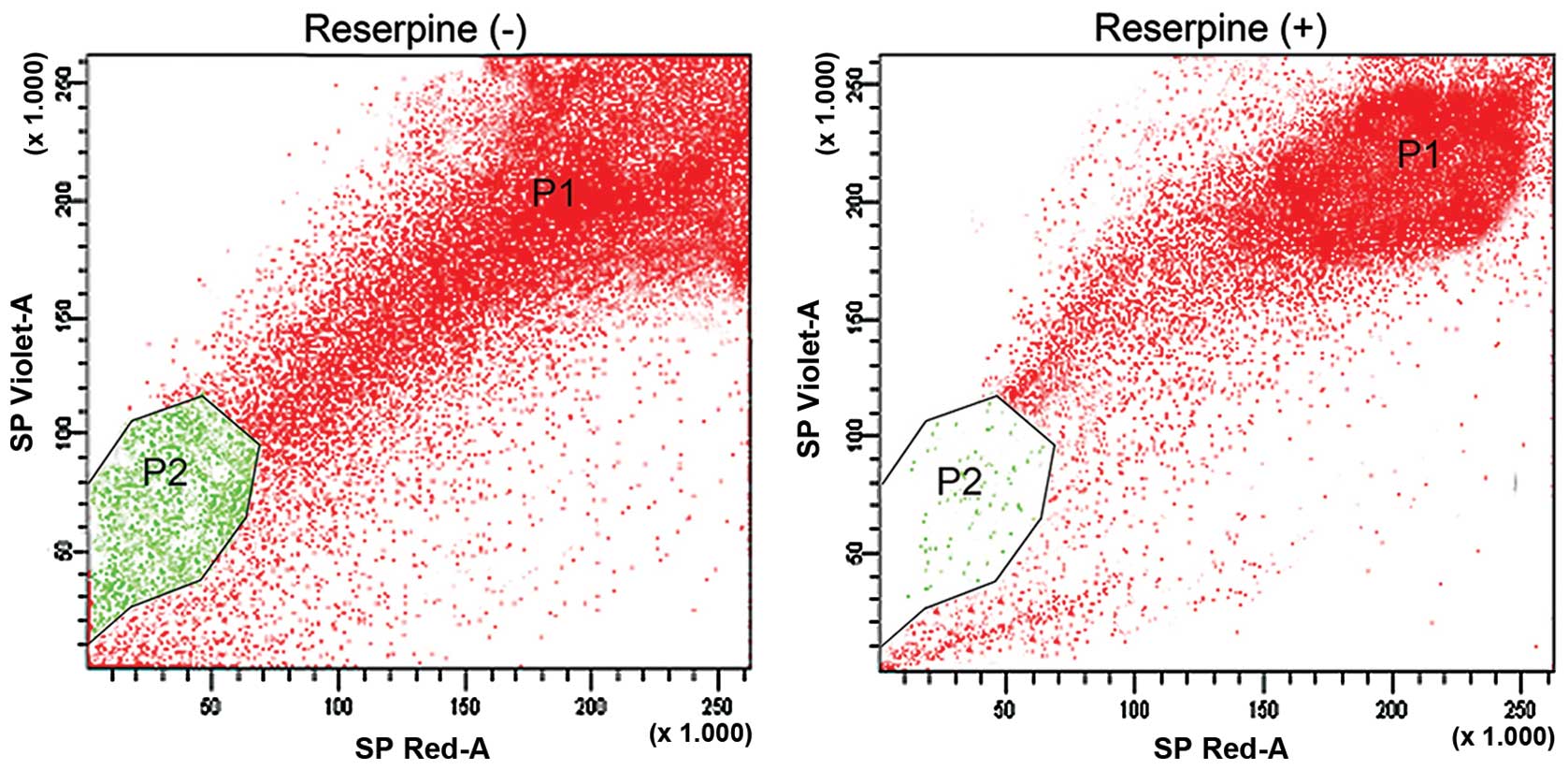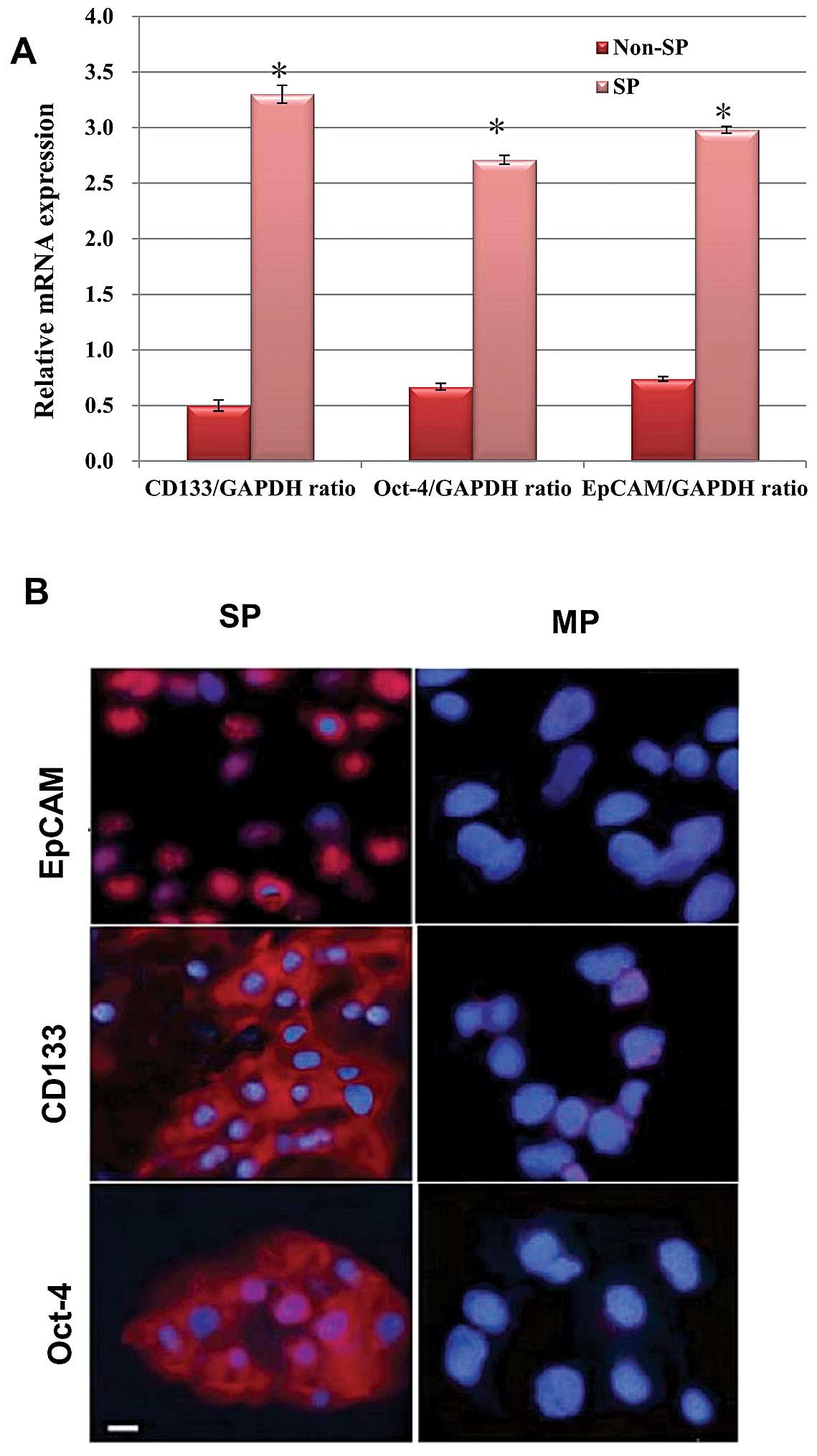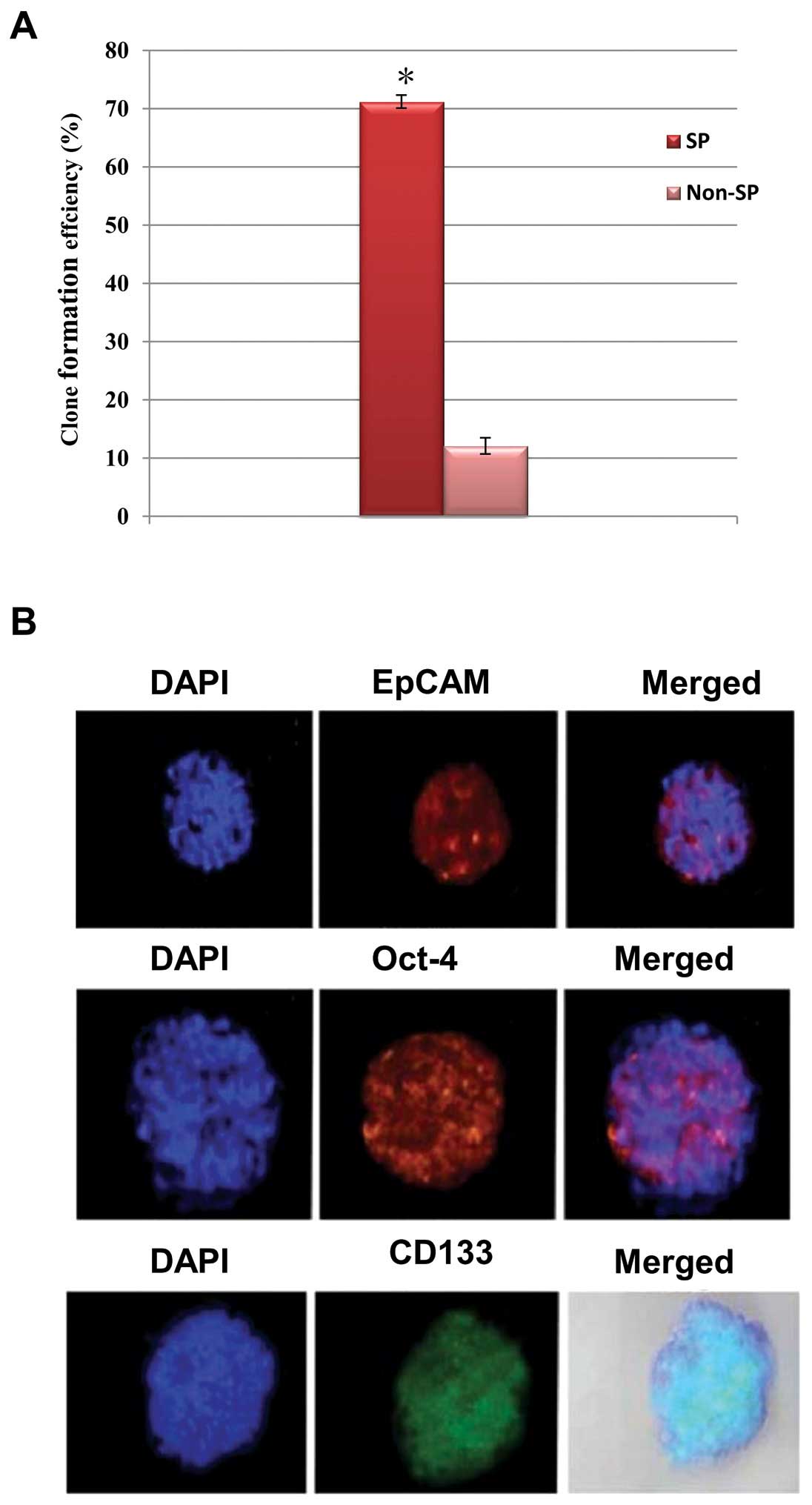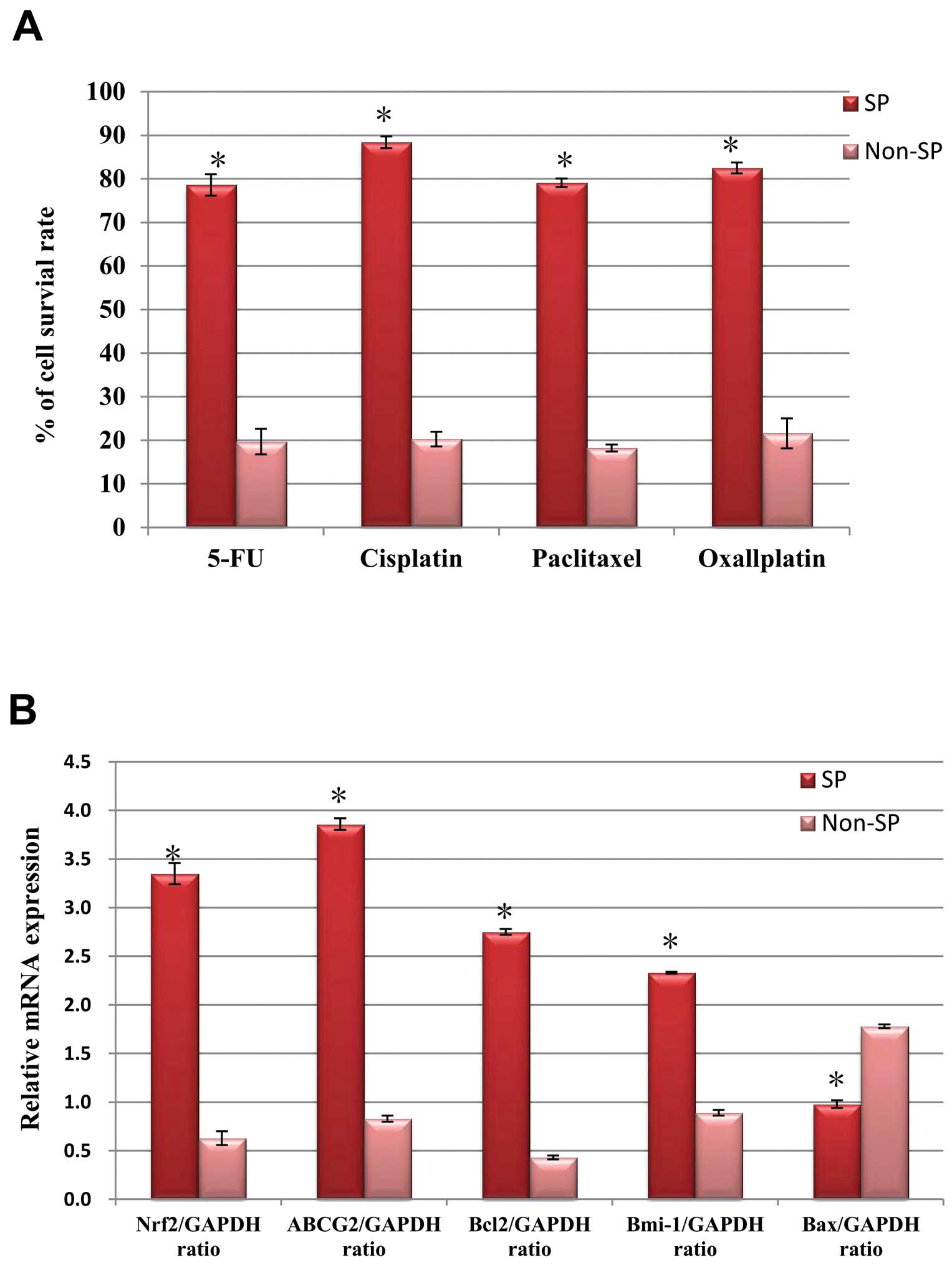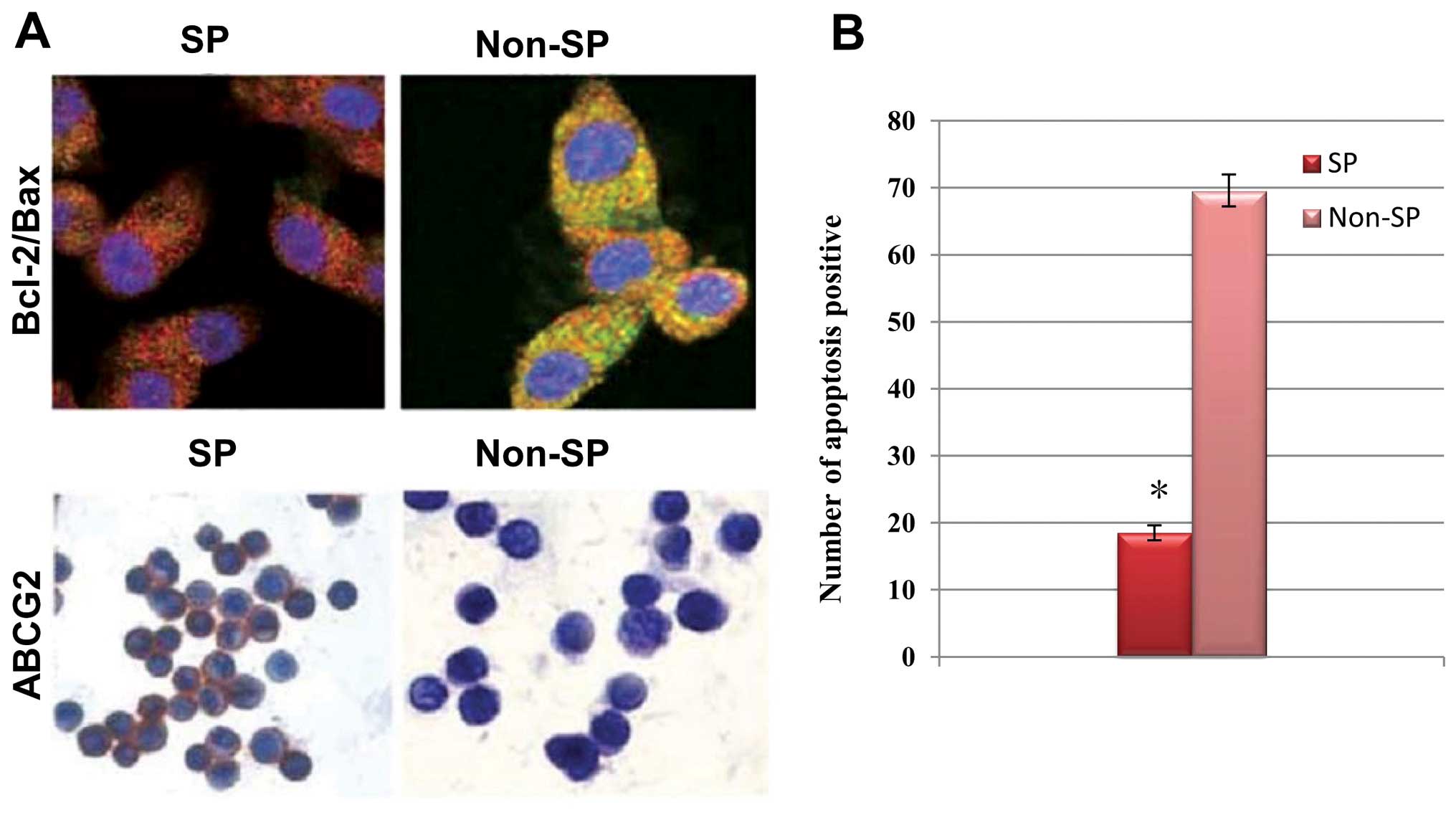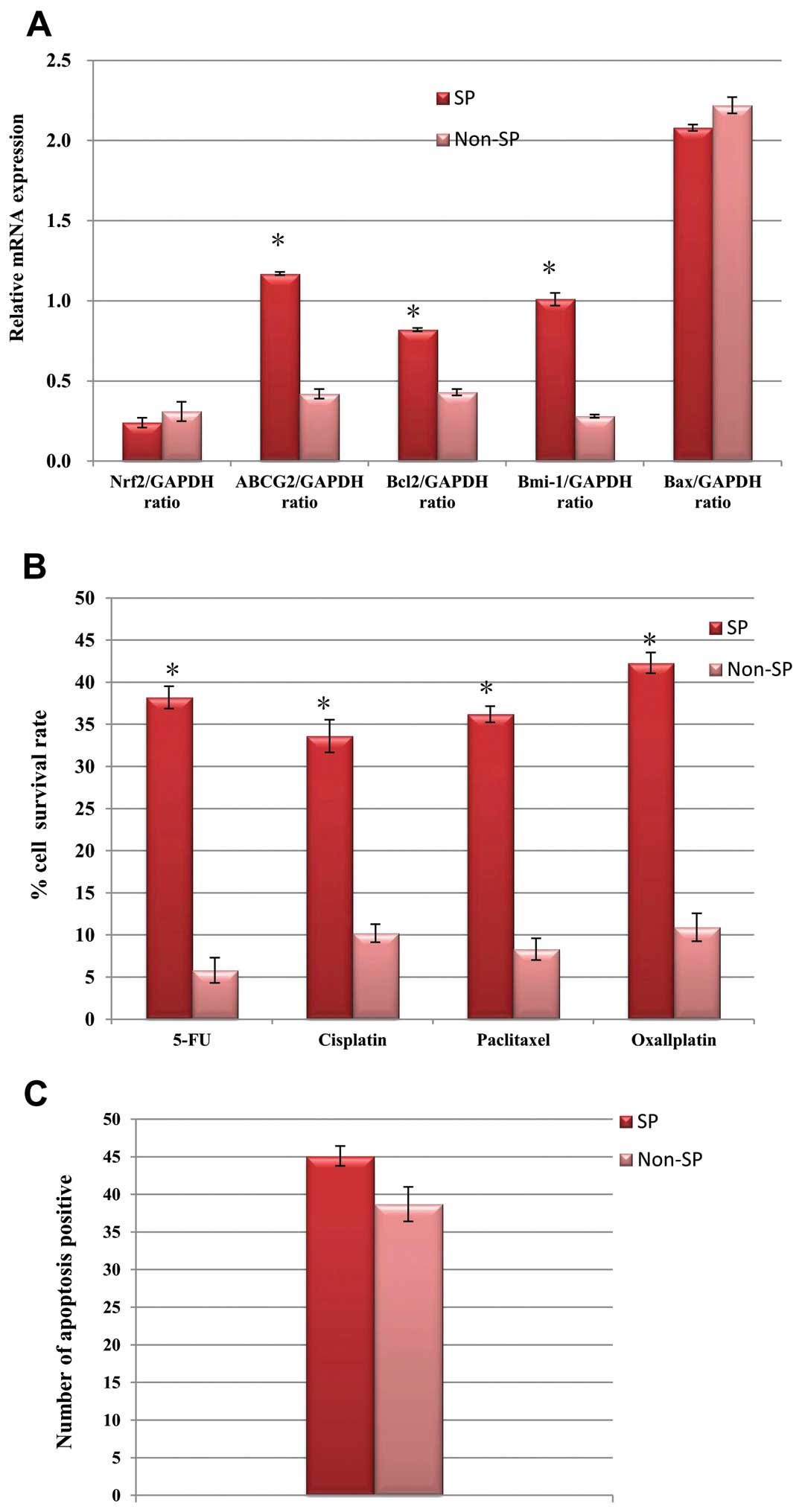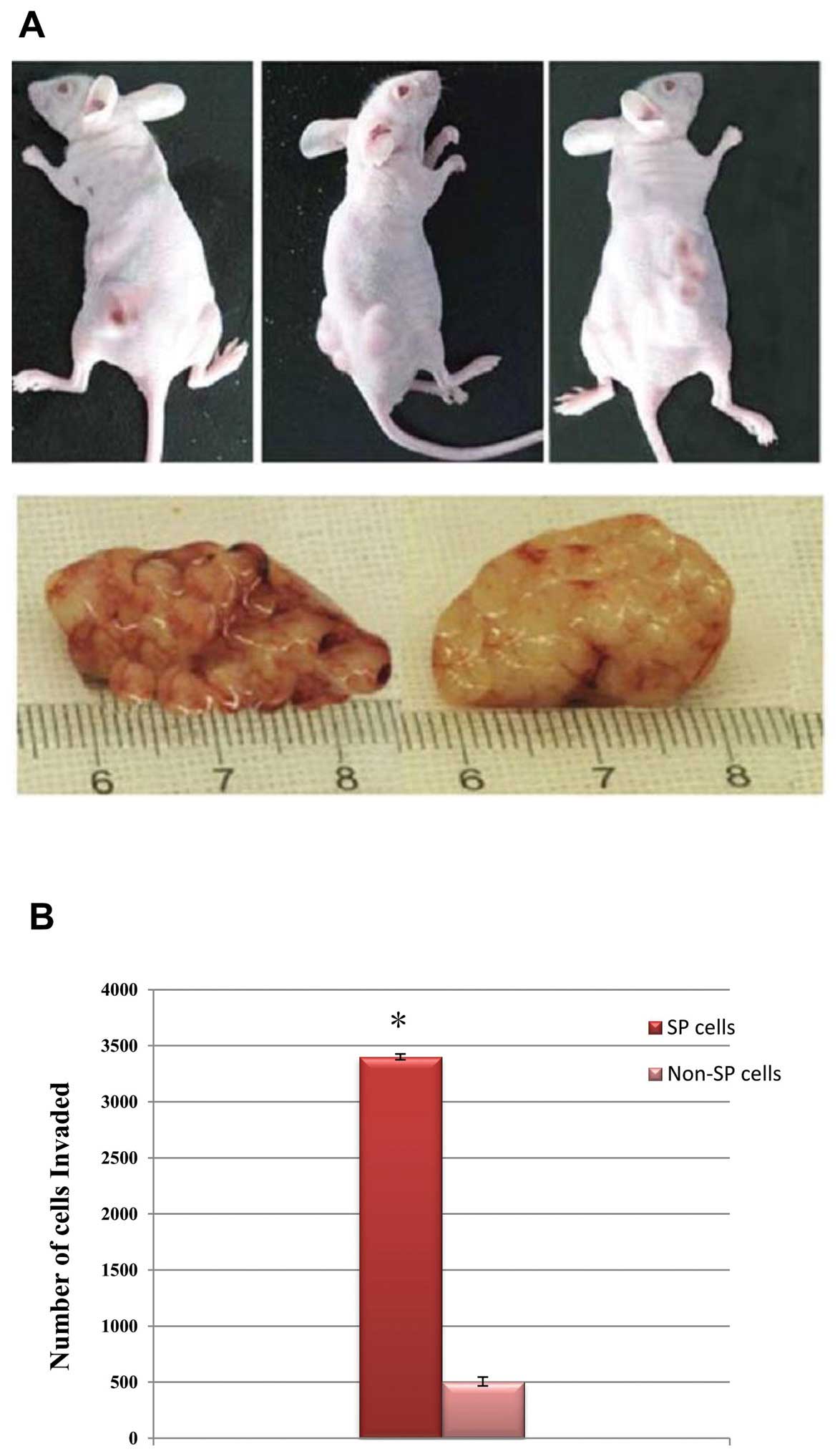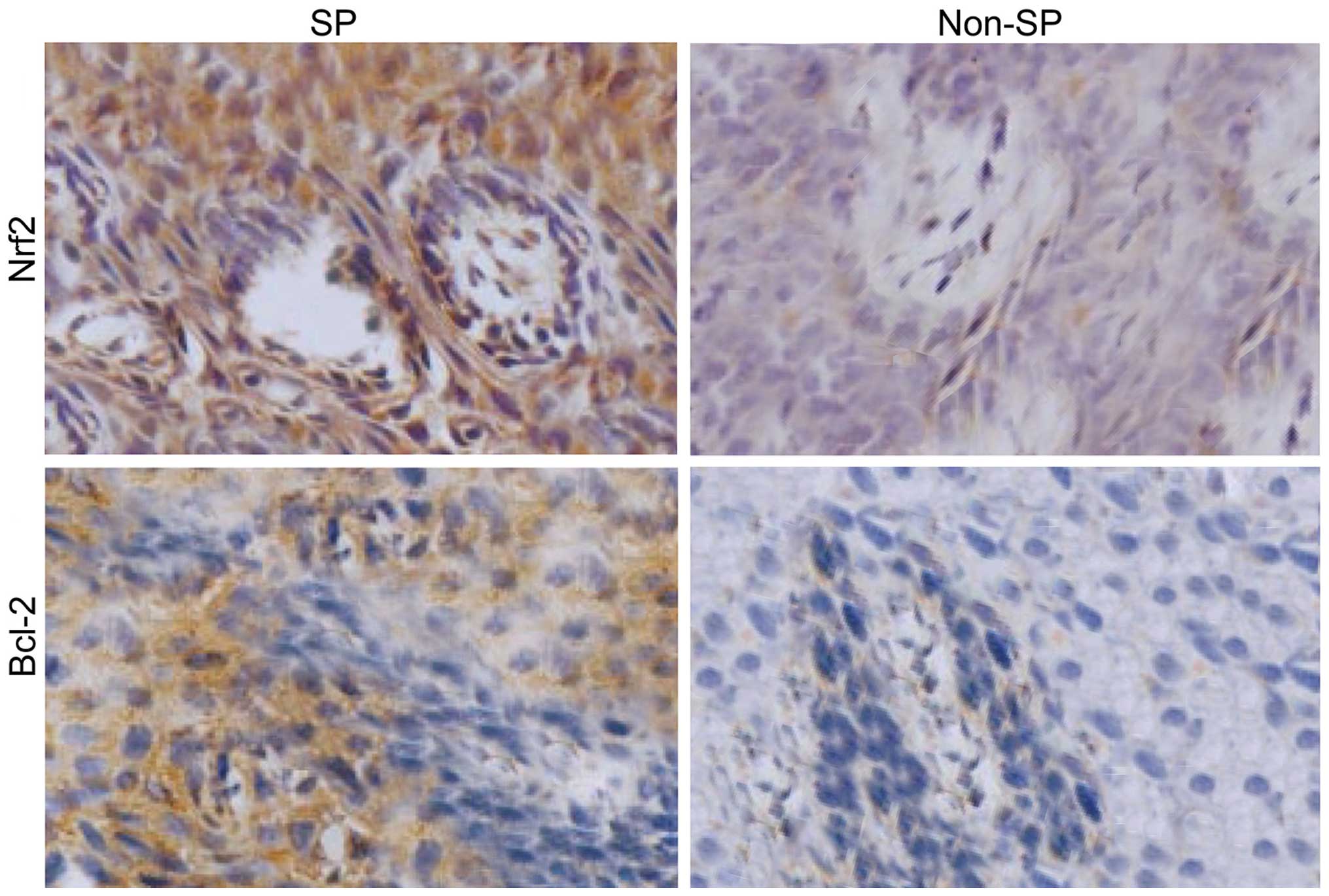Aberrantly elevated redox sensing factor Nrf2 promotes cancer stem cell survival via enhanced transcriptional regulation of ABCG2 and Bcl-2/Bmi-1 genes
- Authors:
- Published online on: August 20, 2015 https://doi.org/10.3892/or.2015.4214
- Pages: 2296-2304
Abstract
Introduction
Cervical cancer is one of the most common gynecological malignancies, resulting in a significant mortality rate in women worldwide (1,2). In most cases, cervical cancer is treated by hysterectomy or primary radiotherapy after diagnosis at early stages (1,2). However, patients at an advanced stage of cancer progression (regional and distant metastases) are generally treated with the combination of radio and chemotherapy. Despite the significant improvements in cancer treatment strategies, the overall survival of cervical cancer patients has yet to be determined. After treatment, >75% of patients have recurrence within 1–2 years, resulting in tumor invasion and metastasis (3).
Studies conducted on different solid tumors reported that the persistence of cancer stem cells (CSCs) are the major factor responsible for therapy failure and tumor recurrence (4–7). A proposed cancer stem cell theory suggested that CSCs are a small subpopulation within the heterogenous tumor (7,8) and are highly potent with regard to differentiation, infinite proliferation rate, self-renewal, tumorigenesis and invasion (7–9). Therefore, it is important to isolate and characterize CSCs to gain a better understanding of CSC-meditated tumorigenesis and metastasis. CSCs have been isolated based on their property of Hoechst 33342 dye exclusion by using fluorescence-activated cell sorting (FACS) analysis. During the FACS analysis, these CSCs were reduced on the left side of the dot plot FACS analysis quadrant and designated as side population (SP) cells (10). These SP cells share all the significant features of CSCs and elevated ATP-binding cassette (ABC) transporter protein, while ABCG2 in SP cells has been shown to be involved in Hoechst 33342 efflux or multidrug resistance (11–13). In the present study, we aimed to characterize the cervical CSCs to gain a better understanding of Nrf2-mediated drug and apoptosis resistance of CSCs.
Materials and methods
Cancer samples and cell culture
Cervical cancer samples were collected from patients at the time of surgery in the Department of Obstetrics and Gynecology in accordance with the ethical principles approved by The Second Hospital of Jilin University, China. A total of 15 samples were collected by punch biopsies. The total number of patients was 30, with an age range of 39–43. Three poorly differentiated carcinomas (PDSCC), 15 high-grade SILs and 12 well-differentiated squamous cell carcinomas (WDSCC) were identified. The corresponding control non-malignant cervical epithelial tissues were obtained from healthy groups at the time of hysterectomy. The cancer tissues were then washed and further processed as previously described (14).
FACS analysis
By using a hemocytometer, ~106 cells were taken and divided into two groups. In group I, the cells were labeled with Hoechst 33342 dye alone (n=11) and in group II, the cells were treated with the reserpine drug and Hoechst 33342 dye (n=11). Subsequently, the cells were counterstained with propidium iodide (PI) 2 µg/ml and analyzed by flow cytometer.
Assays
Cell resistance, Matrigel invasion, sphere formation and TUNEL assays were performed exactly as previously described (15,16).
Tumor cell implantation
The FACS sorted SP and non-SP cells (4×103 cells) were administered into NOD/SCID mice by subcutaneously injection. The density of the injected cells and mice growth was monitored as previously described (17). After 3–4 weeks, the derived tumors from the sacrificed mice were removed.
Reverse transcription (RT)-quantitative polymerase chain reaction (qPCR)
Total RNA was extracted and complementary DNA was prepared using Reverse Transcriptase kit (Fermentas). RT-qPCR analysis was performed on an iCycler IQ real-time detection system, using an IQ Supermix with SYBR-Green (both from Bio-Rad, Hercules, CA, USA). The sequences of human specific primers used were as follows (15,16): ABCG2 forward, TCA ATC AAA GTG CTT CTT TTT TATG and reverse, TTG TGG AAG AAT CAC GTG GC); Nrf2 forward, ACA CGG TCC ACA GCT CAT C and reverse, TGC CTC CAA AGT ATG TCA ATC A); GAPDH forward, ATG TCG TGG AGT CTA CTG GC and reverse, TGA CCT TGC CCA CAG CCT TG); Oct-4 forward, TCG AGA ACC GAG TGA GAG GC and reverse, CAC ACT CGG ACC ACA TCC TTC); Bmi-1 forward, CTCCCAACTGGTTCGACCTT and reverse, CGGTTTCCATATTTCTCAGT); CD133 forward, TCT TGA CCG ACT GAG AC and reverse, ACT TGA TGG ATG CAC CAA GCA C); EpCAM forward, CTG CCA AAT GTT TGG TGA TG and reverse, ACG CGT TGT GAT CTC CTT CT); BCl-2 forward, ACA CTG TTA AGC ATG TGC CG and reverse, CCA GCT CAT CTC ACC TCA CA); and Bax forward, GGA TGC GTC CAC CAA GAA and reverse, ACT CCC GCC ACA AAG ATG) (17–20). The PCR parameters used to set the PCR reactions were: Initial denaturation at −95°C for 15 sec; annealing at −58°C for 45 sec; and extension at −60°C for 30–45 sec, for 35 cycles. The amplified products were visualized by ethidium bromide-stained 1.2% agarose gels. Image J was used to measure the band intensity. The data presented in the graph are the average values of three independent experiments.
RNA interference
Small interfering RNA (siRNA) specific to the Nrf2 gene was purchased from Dharmacon (Lafayette, CO, USA). siRNA transfection (final concentration of 200 nm) was performed as per the Dharmacon protocol by using Oligofectamine 2000 (Invitrogen-Life Technologies, Carlsbad, CA, USA). The transfected siRNA cells were analyzed after 48 h.
Immunofluorescent staining
The SP cells and main population cells were seeded in cover slips on 12-well plates (1×105 cells/well). The primary antibodies used were mouse anti-CD133 (1:100), anti-Oct-4 (1:200), anti-EpCAM (1:200), anti-ABCG2 (1:1,000), anti-bcl2 (1:100) and anti-Bax (1:200). After 24-h incubation in 1% BSA-TBS the antibodies were incubated overnight at 40°C. After washing with 1X PBS, the cells were incubated with secondary antibody conjugated with FITC (dilution: 1:1,000 in 1% BSA-TBS), at room temperature for 1–2 h. For immunohistochemistry, the tissues were processed with CD133 as previously described (21) and stained with mouse anti-CD133 (1:100) and rabbit anti-Nrf2. Tissues and cells were stained with Hoechst 33342 (dilution: 1:100; Bio-Rad) dye to visualize the nucleus.
The immunostaining of squamous spheres were performed as previously described (12). Spheres were fixed onto glass slides in ice-cold 4% paraformaldehyde (40°C for 10 min), blocked with normal serum for 30 min, and incubated with mouse monoclonal anti-Oct-4 and CD44 (1:200; Chemicon, Japan) overnight. After being washed with PBS, the slides were incubated with FITC-conjugated chicken anti-rat IgG overnight in the dark. Nuclei were counterstained with 4,6-diamidino-2-phenylindole (DAPI). The cells and tissues were subsequently viewed under a confocal laser scanning microscope (Leica TCS, Mannheim, Germany). Image analysis and figures were prepared using Adobe Photoshop CS6.
Western blot analysis
Proteins were extracted from the SP and non-SP cells, and protein concentration was determined using the Bradford assay (15). Primary antibodies (rabbit anti-human ABCG2, Nrf2 and GAPDH) were incubated overnight, followed by a secondary antibody (goat anti-rabbit IgG with alkaline phosphatase markers) and a chemiluminescence reagent. Blots were detected using gel documentation and scanned using a densitometer (GS-710; Bio-Rad).
Statistical analysis
A one-way analysis of variance (ANOVA) and Student's t-test were performed to determine the significant difference between the treatment and control groups. A probability level of P<0.05 or 0.01 was considered statistically significant.
Results
Flow cytometry-based purification of cancer stem-like SP cells
In the FACS analysis, cells passing through the laser beam were considered forward and side scatter cells correlating with cell size and population density, respectively. Using PI staining, dead cells were excluded and the main population was gated as a P1 region. The cancer cells that efficiently effluxed the DNA binding dye Hoechst 33342 and were reduced in the left lower quadrant of the FACS profile were termed as 'side population (SP)' cells. We found ~3.1% of SP cells (P2-gated population) from cervical cancer samples, which actively pumped out the Hoechst 33342 dye (Fig. 1A). The process of drug expulsion by SP cells occurred due to the overexpression of the ABC transporter protein, ABCG2. As a confirmatory test we treated the cervical cancer samples with the ABC inhibitor reserpine and analyzed using FACS. Following treatment with reserpine, the SP cell population was dramatically reduced to 0.9% (Fig. 1B). Thus, the results suggested that the presence of ABC proteins in SP cells is significant for the expulsion of DNA binding dyes.
Cervical cancer SP cells possess properties of embryonic stem cells
The FACS sorted SP and non-SP cells were further analyzed for the association of stem cell features. First, we evaluated the expression of stem cell surface genes, such as Oct-4, CD133 and EpCAM, between the SP and non-SP cells using RT-PCR analysis. As shown in the graph (Fig. 2A), the transcriptional regulation of the abovementioned genes are significantly upregulated in the SP cells than non-SP cells. In addition, our immunofluorescence assay revealed that the SP cells exhibited increased positivity towards these proteins, whereas the non-SP cells exhibited null or less positivity towards these proteins (Fig. 2B). Thus, the over-expression of these stem cell proteins may be involved in the self-renewal process. Therefore, we performed a sphere formation assay to determine the ability of self-renewal of SP cells. As expected, the SP cells produced significantly more tumor spheres and generally the tumor size was much larger than that of the SP cells (Fig. 3A). Of note, the spheres generated by the SP cells were highly positive towards stem cell surface proteins such as CD133, EpCAM and Oct-4 (Fig. 3B). Therefore, an increased expression of stemness genes in SP is crucial for the maintenance of self-renewal of the cancer stem-like SP cells.
Elevated Nrf2 attenuates apoptosis and multidrug intake
We performed a drug resistance assay to compare the cell survival rate between the SP and non-SP cells. As shown in Fig. 4A, the SP cells were more resistant to 5-fluorouracil (5-FU), cisplatin, paclitaxel and oxaliplatin. The survival rates of the SP cells were significantly higher (>75%) following treatment with the multidrugs than the non-SP cells (<20%). It has been shown that the aberrant upregulation of Nrf2 was involved in the regulation of ABC genes, thus ultimately resulting in chemotherapy resistance of the SP cells (22). Therefore, we evaluated the transcriptional expression of the Nrf2 gene in the SP and non-SP cells. The relative mRNA expression of the Nrf2 gene was significantly enhanced in the SP cells in conjunction with the elevated mRNA expression of the ABC transporter ABCG2 and anti-apoptotic genes such as Bcl-2 and Bmi-1 than in the non-SP cells (Fig. 4B). However, Bax gene expression was significantly reduced in the SP cells as compared to the non-SP cells. In addition, our immunofluorescence results revealed that the cervical cancer SP cells exhibited enhanced positivity towards ABCG2 and Bcl-2, but decreased positivity towards Bax proteins as compared to the non-SP cells (Fig. 5A). As a consequence of the aberrant regulation of the ABCG2 and anti-apoptotic gene expression profiles, the number of SP cells that underwent apoptosis was markedly decreased compared to that of the non-SP cells (Fig. 5B). These results suggested that the elevated expression of Nrf2 is crucial in the long-term survival of cancer stem cells by upregulating and downregulating the drug efflux and apoptosis mechanism, respectively.
siRNA interference of Nrf2 enhances drug and apoptosis sensitivity of SP cells
We examined whether the rapid inactivation of Nrf2 downregulated the ABC transporter and anti-apoptotic genes. Thus, we used a silencing RNA approach to inactivate the Nrf2 gene rapidly and temporarily. After silencing the Nrf2 gene in the SP cells, the transcriptional regulation of the ABCG2, Bcl-2 and Bmi-1 genes was significantly downregulated (Fig. 6A). Consequently, the SP cells were more sensitive towards multidrug treatment, as the survival rate of SP cells was significantly reduced (Fig. 6B). Similarly, the number of SP cells that underwent apoptosis was significantly elevated after Nrf2 inactivation (Fig. 6C). These results suggested that an elevated Nrf2 is a major causative factor for chemotherapy failure and poor survival rate of cancer patients.
Nrf2-upregulated SP cells are highly tumorigenic and invasive
To determine the tumorigenicity of FACS-sorted Nrf2-overexpressed SP cells, we implanted the lowest density (4×103 cells) of the SP and non-SP cells separately into the NOD/SCID mice. The SP cells were highly potent for initiating rapid tumor growth in the NOD/SCID mice and the tumor size was larger (Fig. 7A), whereas the non-SP cells failed to generate tumors at this cell concentration. The Matrigel invasive assay revealed that the SP cells were highly invasive (Fig. 7B). Furthermore, the tumor tissues derived from SP-induced cells showed an enhanced Nrf2 and Bcl-2 staining compared to the non-SP tissues (Fig. 8). These results clearly suggested that the presence of SP cells are the major factor involved in tumor recurrence, invasion and metastasis after chemotherapy failure.
Discussion
The heterogenous population of cancer cells contains a small proportion of tumor-initiating cells termed cancer stem cells (CSCs), responsible for multidrug therapy failure and tumor relapse as they are capable of self-renewal (23–25). CSCs have been isolated and characterized in different solid tumors such as pancreatic carcinoma, ovarian and prostate cancer (4–7). Additionally, CSCs are highly aggressive and resistant to multidrug treatment and apoptosis (4–7). The increased multidrug resistance properties of CSCs are mainly due to the higher expression levels of drug efflux pumps such as ABC transporters ABCG2 and Bcrp1 which are encoded by multi-drug-resistant (MDR) gene 1 (12). However, investigations into CSCs to identify novel signaling and aberrantly upregulated proteins in CSCs may be useful to developing novel and effective anticancer drugs.
In the present study, by using the Hoechst 33342 dye exclusion assay we have isolated and characterized the cancer stem-like SP cells from cervical cancer samples. We have found a significant amount (3.1%) of cervical cancer SP cells. The SP cell population possesses overexpression of ABC transporter proteins such as ABCG2. Similarly, it has been previously showed in cervical cancer that HeLa stem cells possess the highly expressed MDR protein Bcrp1 (3). Furthermore, we have demonstrated that FACs-sorted cervical cancer SP cells are capable of self-renewal as they express higher levels of stem cell surface proteins such as CD133, CD44, EpCAM and Oct-4, which are involved in the maintenance of self-renewal. These proteins are also responsible for the higher cell proliferation rate and rapid generation of tumor spheres because the FACs-purified SP cells are able to initiate tumor spheres. These tumor spheres are highly positive for CD133, CD44 and Oct-4. With regard to these findings, it has been previously shown that Bcrp1+ cells underwent rapid proliferation and they are capable of self-renewal (3,26). Another interesting phenotype of the SP cells we identified is that they are highly resistant to multidrugs and apoptosis. Furthermore, these SP cells can initiate tumor growth in NOD/SCID mice even at the lowest cell concentration, confirming that SP cells are capable of causing tumor recurrence and invasion following therapy failure. Similarly, the Bcrp1+/CD44+ cervical cancer SP cells are highly tumorigenic and induce rapid tumor growth in NOD/SCID mice (9). Overexpression of the stem cell surface protein CD133 in different types of cancer has been shown to be involved chemoresistance, self-renewal and tumorigenesis in vitro and in vivo (27). However, the signaling mechanism and downstream pathways involved in drug resistance, apoptosis resistance and tumor recurrence remain to be determined.
The major role of Nrf2 is providing protection to the cells from oxidative stress and other environmental cues, such as xenobiotics. Generally, the downstream signaling of Nrf2 leads to activation of several antioxidant enzymes and an elevated expression of various drug efflux transporter proteins on the cell surface (28–30). On the other hand, negative regulation of Nrf2 leads to ubiquitin-mediated proteosomal degradation by KEAP1 (31,32). loss of Nrf2-KEAP1 interaction or point mutations in KEAP1 has been found to lead to the upregulation of the Nrf2 gene, which is often present in primary tumors (33,34). Studies in lung cancer stem cells reported that upregulated Nrf2 leads to the overexpression of ABC transporter proteins, contributing to chemotherapy failure (2,12,17). Furthermore, depletion of Nrf2 leads to the suppression of ABC transporter gene expression and its function (22). Similarly, we have demonstrated that cervical cancer SP cells possess an aberrantly elevated level of the Nrf2 transcript and consequently the transcriptional regulation of ABCG2 and Bcl2/Bmi-1 are highly upregulated. Furthermore, we have shown that silencing of the Nrf2 gene expression attenuated the expression of ABCG2, Bcl-2 and Bmi-1, rendering the SP cells more sensitive to drug treatment and efficiently subjected to apoptosis. There is a high risk of alteration in programmed cell death during carcinogenesis associated with mutation in the p53 gene and modulation of apoptotic regulatory Bcl-2, Bmi-1 and Bax proteins in cervical CSCs (18). Inactivation of the p53 gene induces the production of other pro-apoptotic proteins such as Bax and represses the anti-apoptotic factors such as Bcl-2 and Bmi-1 (18). Therefore, we hypothesized that an elevated level of Nrf2 may be involved in the inactivation of the p53 gene and its function.
Taken together, our results suggest that elevated Nrf2 signaling in cervical cancer SP cells are a major root cause for DNA targeting drug and cell death resistance. Future studies concerning elucidation of the precise molecular mechanism behind the regulatory pathways and additional factors involved in Nrf2-mediated ABCG2/Bcl-2 overexpression may provide insight into the development of novel anticancer drugs that effectively suppress Nrf2 signaling and the function of drug efflux pumps.
Acknowledgments
The present study is supported by the Youth Fund of Science and Technology Department, Jilin (no. 201201034). We would like to thank Dr Wanshan Li (Department of Oral and Maxillofacial Surgery, Children's Hospital, Chongqing Medical University); Dr Yang Liu (Department of Thoracic Surgery, Chinese PLA General Hospital); Dr Nan Jiang (Department of Hepatic Surgery, The Third Affiliated Hospital of Sun Yat-Sen University); Dr Yang Liu, (Department of Thoracic Surgery, Chinese PLA General Hospital); and Dr Xue-Hui Wang (Department of Gynecology, The Affiliated Zhongshan Hospital of Dalian University) for their helpful guidance, collaboration and sharing of all the important protocols and primers.
References
|
Bansal N, Herzog TJ, Shaw RE, Burke WM, Deutsch I and Wright JD: Primary therapy for early-stage cervical cancer: Radical hysterectomy vs radiation. Am J Obstet Gynecol. 201:485.e1–485.e9. 2009. View Article : Google Scholar | |
|
Kosmas C, Mylonakis N, Tsakonas G, Vorgias G, Karvounis N, Tsavaris N, Daladimos T, Kalinoglou N, Malamos N, Akrivos T, et al: Evaluation of the paclitaxel-ifosfamide-cisplatin (TIP) combination in relapsed and/or metastatic cervical cancer. Br J Cancer. 101:1059–1065. 2009. View Article : Google Scholar : PubMed/NCBI | |
|
Zhang SL, Wang YS, Zhou T, Yu XW, Wei ZT and Li YL: Isolation and characterization of cancer stem cells from cervical cancer HeLa cells. Cytotechnology. 64:477–484. 2012. View Article : Google Scholar : PubMed/NCBI | |
|
Bapat SA, Mali AM, Koppikar CB and Kurrey NK: Stem and progenitor-like cells contribute to the aggressive behavior of human epithelial ovarian cancer. Cancer Res. 65:3025–3029. 2005.PubMed/NCBI | |
|
Collins AT, Berry PA, Hyde C, Stower MJ and Maitland NJ: Prospective identification of tumorigenic prostate cancer stem cells. Cancer Res. 65:10946–10951. 2005. View Article : Google Scholar : PubMed/NCBI | |
|
Olempska M, Eisenach PA, Ammerpohl O, Ungefroren H, Fandrich F and Kalthoff H: Detection of tumor stem cell markers in pancreatic carcinoma cell lines. Hepatobiliary Pancreat Dis Int. 6:92–97. 2007.PubMed/NCBI | |
|
Tu SM, Lin SH and Logothetis CJ: Stem-cell origin of metastasis and heterogeneity in solid tumours. Lancet Oncol. 3:508–513. 2002. View Article : Google Scholar : PubMed/NCBI | |
|
Szotek PP, Pieretti-Vanmarcke R, Masiakos PT, Dinulescu DM, Connolly D, Foster R, Dombkowski D, Preffer F, Maclaughlin DT and Donahoe PK: Ovarian cancer side population defines cells with stem cell-like characteristics and Mullerian inhibiting substance responsiveness. Proc Natl Acad Sci USA. 103:11154–11159. 2006. View Article : Google Scholar : PubMed/NCBI | |
|
Al-Hajj M, Wicha MS, Benito-Hernandez A, Morrison SJ and Clarke MF: Prospective identification of tumorigenic breast cancer cells. Proc Natl Acad Sci USA. 100:3983–3988. 2003. View Article : Google Scholar : PubMed/NCBI | |
|
Goodell MA, Brose K, Paradis G, Conner AS and Mulligan RC: Isolation and functional properties of murine hematopoietic stem cells that are replicating in vivo. J Exp Med. 183:1797–1806. 1996. View Article : Google Scholar : PubMed/NCBI | |
|
Zhou S, Schuetz JD, Bunting KD, Colapietro AM, Sampath J, Morris JJ, Lagutina I, Grosveld GC, Osawa M, Nakauchi H, et al: The ABC transporter Bcrp1/ABCG2 is expressed in a wide variety of stem cells and is a molecular determinant of the side-population phenotype. Nat Med. 7:1028–1034. 2001. View Article : Google Scholar : PubMed/NCBI | |
|
Hirschmann-Jax C, Foster AE, Wulf GG, Nuchtern JG, Jax TW, Gobel U, Goodell MA and Brenner MK: A distinct 'side population' of cells with high drug efflux capacity in human tumor cells. Proc Natl Acad Sci USA. 101:14228–14233. 2004. View Article : Google Scholar | |
|
Wulf GG, Wang RY, Kuehnle I, Weidner D, Marini F, Brenner MK, Andreeff M and Goodell MA: A leukemic stem cell with intrinsic drug efflux capacity in acute myeloid leukemia. Blood. 98:1166–1173. 2001. View Article : Google Scholar : PubMed/NCBI | |
|
Qin Zl, Zheng XX and Xu YH: Increased angiogenesis and decreased programmed cell death increases the risk of uterine cervical cancer. Drug Res. Oct 21–2014.Epub ahead of print. | |
|
Yang B, Ma YF and Liu Y: Elevated expression of Nrf-2 and ABCG2 involved in multi-drug resistance of lung cancer SP cells. Drug Res. Nov 4–2014.Epub ahead of print. | |
|
Zhang QH, Dou HT, Xu P, Zhuang SC and Liu PS: Tumor recurrence and drug resistance properties of side population cells in high grade ovary cancer. Drug Res. 65:153–157. 2015. | |
|
Shi Y, Fu X, Hua Y, Han Y, Lu Y and Wang J: The side population in human lung cancer cell line NCI-H460 is enriched in stem-like cancer cells. PLoS One. 7:e333582012. View Article : Google Scholar : PubMed/NCBI | |
|
Fan J, Li R, Zhang R, Liu HL, Zhang N, Zhang FQ and Dou KF: effect of Bcl-2 and Bax on survival of side population cells from hepatocellular carcinoma cells. World J Gastroenterol. 13:6053–6059. 2007. View Article : Google Scholar : PubMed/NCBI | |
|
Park JR, Kim RJ, Lee YK, Kim SR, Roh KJ, Oh SH, Kong G, Kang KS and Nam JS: Dysadherin can enhance tumorigenesis by conferring properties of stem-like cells to hepatocellular carcinoma cells. J Hepatol. 54:122–131. 2011. View Article : Google Scholar | |
|
Shimamura T, Yasuda J, Ino Y, Gotoh M, Tsuchiya A, Nakajima A, Sakamoto M, Kanai Y and Hirohashi S: Dysadherin expression facilitates cell motility and metastatic potential of human pancreatic cancer cells. Cancer Res. 64:6989–6995. 2004. View Article : Google Scholar : PubMed/NCBI | |
|
Kim RJ, Kim SR, Roh KJ, Park SB, Park JR, Kang KS, Kong G, Tang B, Yang YA, Kohn EA, et al: Ras activation contributes to the maintenance and expansion of Sca-1pos cells in a mouse model of breast cancer. Cancer Lett. 287:172–181. 2010. View Article : Google Scholar | |
|
Singh A, Wu H, Zhang P, Happel C, Ma J and Biswal S: expression of ABCG2 (BCRP) is regulated by Nrf2 in cancer cells that confers side population and chemoresistance phenotype. Mol Cancer Ther. 9:2365–2376. 2010. View Article : Google Scholar : PubMed/NCBI | |
|
Bonnet D and Dick JE: Human acute myeloid leukemia is organized as a hierarchy that originates from a primitive hematopoietic cell. Nat Med. 3:730–737. 1997. View Article : Google Scholar : PubMed/NCBI | |
|
Lapidot T, Sirard C, Vormoor J, Murdoch B, Hoang T, Caceres-Cortes J, Minden M, Paterson B, Caligiuri MA and Dick JE: A cell initiating human acute myeloid leukaemia after transplantation into SCID mice. Nature. 367:645–648. 1994. View Article : Google Scholar : PubMed/NCBI | |
|
Reya T, Morrison SJ, Clarke MF and Weissman IL: Stem cells, cancer, and cancer stem cells. Nature. 414:105–111. 2001. View Article : Google Scholar : PubMed/NCBI | |
|
Hass R, Giese G, Meyer G, Hartmann A, Dörk T, Köhler L, Resch K, Traub P and Goppelt-Strübe M: Differentiation and retrodifferentiation of U937 cells: Reversible induction and suppression of intermediate filament protein synthesis. Eur J Cell Biol. 51:265–271. 1990.PubMed/NCBI | |
|
Salnikov AV, Gladkich J, Moldenhauer G, Volm M, Mattern J and Herr I: CD133 is indicative for a resistance phenotype but does not represent a prognostic marker for survival of non-small cell lung cancer patients. Int J Cancer. 126:950–958. 2010. | |
|
Itoh K, Chiba T, Takahashi S, Ishii T, Igarashi K, Katoh Y, Oyake T, Hayashi N, Satoh K, Hatayama I, et al: An Nrf2/small Maf heterodimer mediates the induction of phase II detoxifying enzyme genes through antioxidant response elements. Biochem Biophys Res Commun. 236:313–322. 1997. View Article : Google Scholar : PubMed/NCBI | |
|
Ramos-Gomez M, Kwak MK, Dolan PM, Itoh K, Yamamoto M, Talalay P and Kensler TW: Sensitivity to carcinogenesis is increased and chemoprotective efficacy of enzyme inducers is lost in nrf2 transcription factor-deficient mice. Proc Natl Acad Sci USA. 98:3410–3415. 2001. View Article : Google Scholar : PubMed/NCBI | |
|
Kwak MK, Kensler TW and Casero RA Jr: Induction of phase 2 enzymes by serum oxidized polyamines through activation of Nrf2: effect of the polyamine metabolite acrolein. Biochem Biophys Res Commun. 305:662–670. 2003. View Article : Google Scholar : PubMed/NCBI | |
|
Kobayashi A, Kang MI, Okawa H, Ohtsuji M, Zenke Y, Chiba T, Igarashi K and Yamamoto M: Oxidative stress sensor Keap1 functions as an adaptor for Cul3-based E3 ligase to regulate proteasomal degradation of Nrf2. Mol Cell Biol. 24:7130–7139. 2004. View Article : Google Scholar : PubMed/NCBI | |
|
Zhang DD, Lo SC, Cross JV, Templeton DJ and Hannink M: Keap1 is a redox-regulated substrate adaptor protein for a Cul3-dependent ubiquitin ligase complex. Mol Cell Biol. 24:10941–10953. 2004. View Article : Google Scholar : PubMed/NCBI | |
|
Singh A, Misra V, Thimmulappa RK, Lee H, Ames S, Hoque MO, Herman JG, Baylin SB, Sidransky D, Gabrielson E, et al: Dysfunctional KEAP1-NRF2 interaction in non-small-cell lung cancer. PLoS Med. 3:e4202006. View Article : Google Scholar : PubMed/NCBI | |
|
Shibata T, Ohta T, Tong KI, Kokubu A, Odogawa R, Tsuta K, Asamura H, Yamamoto M and Hirohashi S: Cancer related mutations in NRF2 impair its recognition by Keap1-Cul3 E3 ligase and promote malignancy. Proc Natl Acad Sci USA. 105:13568–13573. 2008. View Article : Google Scholar : PubMed/NCBI |



